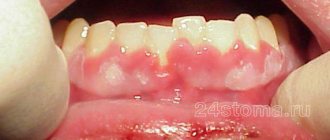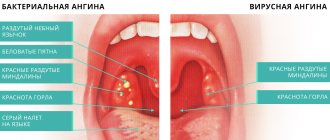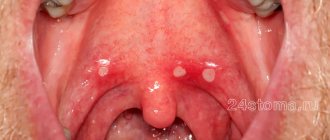Tonsils are collections of lymphoid tissue in the pharynx and oral cavity that protect the respiratory tract from infectious agents. A person has six tonsils:
- two palatines - in the recess between the tongue and the soft palate, they are clearly visible during examination of the throat;
- two tubal - near the openings of the Eustachian tubes in the pharynx;
- one lingual - in the back of the tongue;
- one pharyngeal - in the upper part of the pharynx.
Our expert in this field:
Nasilevsky Pavel Alexandrovich
Oncologist
Call the doctor Reviews about the doctor
Tonsil cancer is a rare cancer that belongs to the group of head and neck tumors. Most often, malignant neoplasms occur in the tonsils. In men, the disease is diagnosed 3–4 times more often than in women. Most patients are 50 years of age and older.
Squamous cell carcinoma most often develops in the tonsils. Sometimes there are lymphomas - malignant neoplasms of lymphoid tissue.
Symptoms of tonsil cancer
- Dysphagia (difficulty swallowing) – the tumor interferes with swallowing, causing difficulty swallowing.
- Odynophagia (pain when swallowing) – the tumor grows, leads to the formation of ulcers, grows into the nerves, which leads to pain.
- Lump – spread of cancer to the lymph nodes makes the tumor clinically noticeable: the patient may notice a firm, palpable mass in the neck.
- Otalgia (ear pain) - the innervation of the oropharynx and ear has some connection, which means that the brain can “replace” pain in the oropharynx with pain in the ear (referred pain). The most alarming is pain in the ear on one side, without any other ear problems, not going away, unexplained by other diseases. It is important to understand that most causes of ear pain are associated with middle ear infection, eustachian tube dysfunction and other diseases of the ENT organs. But a combination of several symptoms may indeed indicate an oncological process.
- Trismus (spasm of the pterygoid muscles, causing difficulty opening the mouth).
- Feeling of a lump in the throat.
- A sore throat.
- Bleeding from the mouth.
- Change in speech (muffled voice).
- Weight loss.
Medial pterygoid muscle. getbodysmart.com
Why do cysts appear on the tonsils?
Only a qualified specialist can indicate the exact cause of the appearance of a cyst on the tonsil, using examination data and a comprehensive examination. Chronic infectious and inflammatory processes in the oropharynx come first in this disease. If the patient suffers from diseases such as tonsillitis, sinusitis, laryngitis, in which there is pronounced swelling of the mucous membrane in the mouth and nose, then favorable conditions are created for tissue proliferation and the growth of pathological neoplasms.
But there are other reasons that lead to the growth of cysts on the tonsils:
- changes in hormonal levels;
- weakening of the body's defenses;
- bad habits (smoking, drinking alcohol);
- tonsil injuries;
- work in hazardous industries associated with inhalation of polluted air poisoned by chemical vapors;
- sluggish inflammatory process in the oropharynx;
- development of autoimmune pathologies;
- untreated tonsillitis.
Diagnostics
- Anamnesis collection, visual examination and palpation of the mucous membranes of the floor of the mouth, the anterior two-thirds of the tongue, the tonsils and base of the tongue, the mucous membrane of the palate, cheeks and gums, and the posterior wall of the pharynx.
- Diagnosis of HPV infection: immunohistochemical determination of the surrogate marker p16 in tumor tissue.
- Computed tomography of the chest and abdominal cavity to exclude metastatic lesions.
- Biopsy – cancer can be diagnosed only by taking a tissue sample from a growth that is suspicious for a malignant process.
- MRI of the soft tissues of the neck provides more accurate detail of the soft tissues compared to CT. Performed to assess the prevalence of the process.
- Ultrasound of the lymph nodes of the neck to determine their structure (if there is metastasis in the lymph nodes, they may not change their size, but the structure of the lymph node changes).
- PET-CT may be ordered if occult distant metastases are suspected in some situations.
- Fibercolonoscopy, fibrogastroduodenoscopy, laryngoscopy and some other studies may also be prescribed.
HPV-associated squamous cell carcinoma of the right tonsil (A) demonstrating p16 overexpression by immunohistochemistry (B) and evidence of high-risk HPV by in situ hybridization (C). Patients with HPV-related tonsil squamous cell carcinoma rarely harbor oncogenic HPV infection at other pharyngeal sites, SelvamThavaraj et all., ELSEVIER April 2014
Complications of tonsil cysts
A cyst on the tonsil is a chronic source of infection that can behave in an unknown way, causing various complications. The neoplasm in the pharynx is constantly rubbed with food, which leads to the formation of a chronic inflammatory process. The longer the patient does not seek medical help, the longer the infection progresses; along with the bloodstream, infectious pathogens are carried to all cells and organs, disrupting their normal functioning.
A long-term infectious process is accompanied by general intoxication of the body. Toxins produced during the activity of pathogenic microorganisms disrupt the functioning of the liver and kidneys, provoke the development of chronic fatigue syndrome, reduce immunity and make a person vulnerable to even the most harmless infections.
Only an otolaryngologist can choose the treatment for a cyst on the tonsils, based on the results of pharyngoscopy. If the doctor suspects the development of a malignant process, a consultation with an oncologist will be required. Other studies may also be prescribed: rhinoscopy, audiometry, computed tomography and magnetic resonance imaging of the brain, otoscopy. In advanced cases, the tumor can grow into nearby tissues, including brain structures.
Determination of stage
Determination of the stage of cancer is carried out according to the TNM system (T - tumor, N - nodulus, M - metastasis), including the size of the primary tumor, the spread of tumor cells to regional (located next to the primary tumor) lymph nodes and to distant areas (lungs, liver) . Today, the Russian Federation has adopted the seventh classification of tumors (the newest is the eighth). The connection between tonsil cancer and HPV infection is also taken into account during staging (but only for the eighth classification) - with similar morphological data of the tumor and its distribution, the stage of tonsil cancer associated with HPV infection is often lower, in contrast to cancer associated with other factors . In general, the prognosis for tonsil cancer associated with HPV infection is more favorable.
Tonsil cancer staging based on tumor size is “T”. headandneckcancerguide.org
Causes of retention cysts
The reasons for the formation of cysts are varied, but more often than others, factors such as:
- chronic inflammation of the tonsils and pharynx with periodic exacerbations - tonsillitis, pharyngitis;
- autoimmune diseases accompanied by the production of a large number of lymphocytes;
- smoking, especially tobacco with a high tar content;
- injuries, including the habit of swallowing small bones;
- hormonal imbalance;
- occupational hazards, inhalation of aggressive aerosols;
- decreased immunity, especially local.
The formation of a cyst is caused by impaired drainage of the mucous lacunae of the tonsils against the background of the inflammatory process.
Treatment
Early tonsil cancer can be treated with radiation therapy or surgery: small tumors confined to normal tonsil tissue can be cured by removing the tonsil (tonsillectomy). If the tumor extends beyond the tonsil itself, then the soft palate and the wall of the pharynx may need to be removed. Depending on the presence of tumor cells in the lymph nodes, lymphatic dissection may be performed - removal of regional lymph nodes (for head and neck tumors, they are located in the neck). Otherwise, the tumor can be treated with radiation without the need for surgery. The effectiveness of radiation therapy and surgery is similar.
So, for the treatment of early tonsil cancer there are two approaches:
- surgical treatment, which, depending on the results of pathomorphological examination, may be continued with a course of radiation therapy (adjuvant radiation therapy) either alone or simultaneously with chemotherapy;
- radiation therapy – alone or simultaneously with chemotherapy (simultaneous chemoradiotherapy).
Late cancer of the tonsils, growing into the peripharyngeal space, penetrating into the bones, base of the skull, and medial pterygoid muscle may be accompanied by symptoms such as temporal pain and trismus (spasm of the masticatory muscles, leading to difficulty opening the mouth). Treatment of advanced cancer is often accompanied by chemoradiotherapy. An option is surgical treatment of advanced cancer followed by chemoradiotherapy.
When performing surgical intervention, the decision on the need for subsequent treatment is made on the basis of a pathomorphological examination of postoperative material. Spread of the tumor beyond the capsule of the lymph node, removal of the tumor outside of healthy tissue (the tumor is not removed radically, that is, not completely), significant spread of the tumor to the lymph nodes and a large size of the primary lesion, as well as tumor invasion of nerves, lymphatic and blood vessels - all these characteristics are predictors of an unfavorable course of the tumor process and may require additional postoperative treatment in the form of reoperation (if the tumor is not completely removed), chemotherapy and/or radiation therapy.
For the treatment of metastatic tonsil cancer (M1), surgical treatment and radiation therapy are not indicated. In this case, the main approach is systemic therapy, the choice of which will be based on the presence/absence of previous systemic treatment, the patient's condition, certain tumor characteristics (PD-L1 expression), the rate of disease progression and some other factors. Options for systemic therapy include chemotherapy drugs: platinum drugs (cisplatin, carboplatin), fluorouracil and taxanes (docetaxel, paclitaxel); targeted drugs (cetuximab); immunotherapy drugs (pembrolizumab, nivolumab). The combination of drug groups is determined by the above characteristics.
In the presence of a single distant metastasis, metastasectomy may be offered in addition to systemic therapy, which is likely to prolong the time to eventual disease progression.
Regardless of the extent of tonsil cancer, patients may be offered participation in clinical trials.
Patients with severe comorbidities and/or poor health status are best treated with supportive care.
Caseous plugs - remains on the battlefield
Tonsils, or tonsils as they are popularly called, are an organ that protects the body from harmful bacteria.
The palatine tonsils are covered with special depressions (lacunae), in which the immune system kills microbes that enter the mouth along with air and food. After the fight, “corpses” of microbes, leukocytes, and food residues remain on the battlefield. But the tonsils of a healthy person are quickly cleared of debris and continue to perform their function. And caseous plugs (tonsillitis) appear when the tonsils are inflamed. Their composition is almost identical to pus, so they cause concern for patients. In fact, the deposits themselves are not dangerous, but they signal the presence of an infection in the oral cavity.
The most common causes of traffic jams are untreated tonsillitis and chronic tonsillitis (inflammation of the tonsils). In addition, deposits can be caused by the following factors:
- chronic runny nose;
- sinusitis;
- adenoids;
- untreated caries;
- smoking;
- hypothermia;
- low immunity.
The disease often occurs in young people under 30 years of age. Sometimes tonsillitis may not make itself felt at all, but in some cases it causes bad breath and interferes with eating.
In addition, as orthodontists note, chronic otolaryngological diseases can cause malocclusion.
Moreover, since everything in the body is interconnected, the situation can turn in the opposite direction. In particular, if care is not taken to straighten teeth in cases of serious anomalies, ENT diseases may also follow.
Therefore, if you are faced with a problem such as caseous plugs, it would not be superfluous to make an appointment with an orthodontist. Your doctor will likely prescribe short-term treatment for your malocclusion with Invisalign aligners.
Such an integrated approach will eliminate the problem on both sides once and for all.
Complications of treatment
Indeed, there are two directions in the treatment of tonsil cancer with the same outcome, but different techniques: surgical treatment and radiation therapy. It is important to note that these approaches will have different complications.
Radiation therapy may be complicated by bone or soft tissue necrosis and swallowing problems, especially in patients with advanced tonsil cancer. Myelitis, trismus, hypoglossal nerve damage, and long-term risk of another malignancy are also possible.
Complications of surgery include difficulty swallowing, fistula formation, failure of flap healing, poor wound healing, and aspiration of food and saliva, sometimes leading to laryngectomy. The risk of severe and/or fatal complications after surgery is higher than with radiation therapy.
Complications of systemic therapy include fatigue, skin toxicity, mucositis, diarrhea, hepatotoxicity, pneumonitis, hypo- and hyperthyroidism, myelotoxicity, neuropathies, metabolic disorders, etc.
Reasons for the formation of papillomas in the mouth and possible locations of their localization
The appearance of all types of papillomas is associated with infection of the patient with the human papillomavirus (HPV). The prevalence of this type of viral agent is very high and reaches 90% of the population in some countries. However, HPV carriage is not always accompanied by the formation of skin tumors. The virus can remain latent for a long time without manifesting itself at all. The formation of papillomas is promoted by factors such as decreased immunity, bad habits, poor nutrition and hormonal imbalance.
Science knows more than 100 types of human papillomavirus. The location of the tumor directly depends on the type of HPV. Papillomas in the mouth, covering the surface of the mucous membrane, are caused by HPV types 13 and 32, affecting various parts of the oral cavity:
- Papillomas on the tongue. The tongue most often undergoes epithelial hyperplasia, which is usually manifested by the formation of fine granularity or single tubercles of the mucous membrane of the tongue. In the first case, multiple small growths are felt as an unpleasant surface roughness, while the second type of neoplasm, being quite large, is often injured and causes its owner not only discomfort, but also pain.
Papillomas on the tongue usually appear in the tip or lateral parts of the organ. Papilloma under the tongue can also be considered a frequent occurrence. The root of the organ is least likely to suffer from such growths. The color characteristics of papilloma vary from light pink to bright red.
- Papilloma in the throat. Papillomas in the throat can remain undiagnosed for a long time, since they usually do not cause significant pain in the patient. Owners of such neoplasms of the mucous membrane note minor discomfort and sore throat, which is not given any importance.
If the papilloma increases in size, it can interfere with normal food intake and even change the voice of its owner, making it more muffled. The growth itself usually looks like a soft whitish or one-time bump with a rough surface. Papillomas on the tonsil are especially common.
- Laryngeal papilloma. One of the most unpleasant types of localization of neoplasms. The fact is that the formation of laryngeal papillomas interferes with the breathing process, which can lead to acute hypoxia. This phenomenon is especially typical for young children who cannot clearly formulate complaints about difficulty breathing.
- Papilloma on the lip. Such epidermal growth usually causes more trouble from an aesthetic point of view than from a physiological point of view. However, excessive growth of the tumor increases the risk of injury during eating or active facial expressions.
- Papilloma on the gum. Usually characterized by the absence of symptoms and any pain. If a papilloma on the gum has formed in a place that is invisible to the patient. It can only be detected by visiting a dentist.
Forecast
The prognosis for patients with HPV-associated tonsil cancer is significantly better than for patients with other etiologies of cancer. It is impossible to predict with high accuracy the life expectancy of a particular patient, but there are average graphs that can be used to determine what percentage of patients with a certain stage are alive after n years: for example, almost 90% of patients with stage I HPV-associated oropharyngeal cancer are alive 4 years after diagnosis, while for HPV-unassociated oropharyngeal cancer at the same stage, only 80% are alive 4 years after diagnosis.
Overall survival of HPV-associated and HPV-non-associated oropharyngeal cancer according to TNM classification 7. ICON-S
Prevention of palatal cysts
It is important to understand that a cyst is usually formed as a result of a long-term inflammatory process. Carrying a bag of pus in the throat is extremely harmful; it is a source of chronic infection. Microbes have access to the bloodstream; if the body is weakened, this can lead to diseases of the heart, joints and kidneys.
ENT doctors at CELT have extensive practical experience in treating tonsil cysts. Specialists are ready to help people of all ages, including children, as well as those who have unsuccessfully tried treatment in other clinics. The main thing is to cooperate with your doctor to complete treatment until complete recovery. You can safely contact our clinic with this problem.









